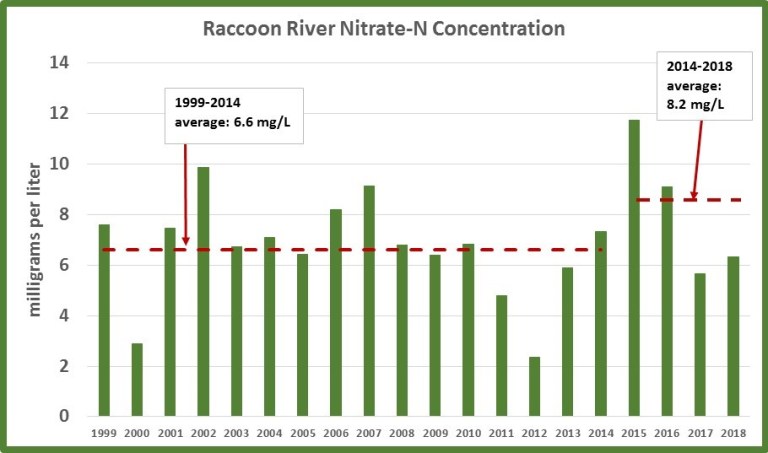
Prologue
“We are actors as well as observers in the drama.” Niels Bohr, Nobel laureate (1922) in physics.
Act I
In 2013, while employed at the Iowa Soybean Association (ISA), I started working on data analysis for a future manuscript I hoped to publish. This project was the culmination of water quality monitoring that began in 1999 for central Iowa’s Raccoon River and its tributaries. The Raccoon River is the primary source of municipal drinking water for the Des Moines area.
Along with the water quality data, I also had access to farmer-reported nitrogen application data for 698 fields, or about 1.2% of the cropped area in the counties of the watershed. Application data for 1.2% of the area may not sound like much, but it is a gold mine when it comes to the sorts of things I do.
The eventual paper, titled Crop Rotation and Raccoon River Nitrate (1), was accepted for publication in late 2015 and ultimately appeared in the Journal of Soil and Water Conservation in May 2016. There were three other authors from ISA and one each from Iowa DNR, the Iowa Geological Survey, and the University of Iowa. The major conclusions of the paper were:
- Nitrate concentrations declined from 1999-2014 at nine of the 41 tributary sites and were increasing at none of them. When the sites were considered in aggregate, concentrations were declining in a statistically significant way.
- Weather was largely driving year-to-year variations in nitrate concentrations.
- Fertilizer use efficiency was not increasing.
- Increasing area planted to corn was displacing soybean acres and resulted in a 24% increase in nitrogen fertilizer inputs. We concluded that decreasing soybean cultivation may have prevented an increase in stream nitrate concentrations by reducing area most vulnerable to nitrate loss, increasing denitrification in the soil profile, and decreasing water throughput in tiled fields. Although a subsequent paper published in late 2016 using statistical modeling supported this conclusion, this is far from being conclusively established.
We didn’t spend a lot of time on this topic, but we did state that refinements in N management and conservation may have been a factor in reduced nitrate concentrations.
Even before the paper was published, people in the Ag industry hailed it as a sign of improvement. The Iowa Farm Bureau Spokesman ran two articles on the research (link, link). This message was also promoted by the Iowa Pork Producers, Wallaces Farmer and the Iowa Drainage District Association. And it wasn’t just the farm media. The work was mentioned in the Des Moines Register and by then-agriculture-secretary Bill Northey and others in the Cedar Rapids Gazette. Northey said “farmers have become more efficient in their use of fertilizer (we didn’t say that), and more of them are adopting conservation practices such as no-till, filter strips and cover crops.” Comments by others in that article included “something has changed in recent years” and “resources in farm bill conservation programs are having an effect.”
I still think this was a good paper and I stand by every word of it. Other data presented by USGS, Iowa DNR, and the Iowa Geological Survey from around that time seemed to show stable or declining nitrate levels in the Raccoon and other Iowa rivers. Much of the above-mentioned media also coincided with the Des Moines Water Works lawsuit and it was pretty clear at the time that the research was benefiting more than just science.
Despite all the crowing about fertilizer efficiency and conservation driving water quality improvements, 11 Iowa Ag-connected groups including the Agribusiness Association of Iowa, Agriculture’s Clean Water Alliance, Iowa Agriculture Water Alliance, Iowa Cattlemen’s Association, Iowa Corn Growers Association, Iowa Farm Bureau Federation, Iowa Pork Producers Association, Iowa Poultry Association, Iowa State Dairy Association, and the Iowa Turkey Federation issued this joint statement in response to the lawsuit: “Nitrate levels in Iowa rivers are complex, fluctuating with weather and soil fertility but not significantly affected by fertilizer application rates or management (my emphasis). Our weather and nutrient-rich soils, which are ideal for growing plants, dominantly influence what happens in Iowa’s waters.”
Hmm. That statement seems to be inconsistent with the scientific literature (link, link, link, link, link, link, link, link, and I could list a lot more)
(curtain falls)
Act II
I’ve been looking at Raccoon River nitrate data forever and continue to do so. So what has happened since 2014, the last year of my data analysis for Crop Rotation and Raccoon River Nitrate? Pictures are worth 1000 words and those shown in Fig. 1 and Fig. 2 below answer the question for the Raccoon near its confluence with the Des Moines River in downtown Des Moines. Nitrate concentrations have increased 24% and loads (total mass transported by the river) have increased 78% since 2014.


The year of 2015 was the biggest ever since 1974 for concentration and load, but not river discharge (3rd biggest). That year (2015) river nitrate was above the drinking water standard (10 mg/L) for 270 days (the previous record was 178 in 2002). In the three years from 2014-2016, it was above 10 mg/L 52% of the time; the 1974-2014 average was 18%.
The river never went below 10 mg/L nitrate from 10/16/14 to 3/5/15 (164 days), 4/8 to 6/15/15 (69 days), and 9/26 to 12/13/15 (79 days).
The period of 1999-2018 provides a neat 20-year window of data. When I divide that into five year chunks, Fig. 3 and Fig. 4 are the result. I haven’t published this data and have not as yet speculated on the drivers. There certainly has been some wet weather these past few years and as I myself have said, weather is a powerful driver of year-to-year variations. That being said, weather does not explain why we have high nitrate values in our streams and willful conflation of the supply and transport drivers of water pollution continues to be a feature of industry and agency rhetoric. However, we know that farmed fields are not Las Vegas, i.e. what happens there doesn’t necessarily stay there. Rumors of fun times with more manure and more tiling do once in a while make it down to Des Moines via the Raccoon River.


Although I have not published any Raccoon River-specific papers in the past couple of years, I have published some manuscripts that describe increasing statewide nitrate loading to the Mississippi River and excess manure fertilization as a driver of western Iowa stream nitrate.
(curtain falls)
Act III
In the third act of the three act structure, the author is supposed to draw the plot strands together in a way that explains and resolves everything. I have thought about this for days and I’m not sure I can, but I’ll try.
If on the one hand the public and especially farmers are made to believe that natural forces (i.e. weather and soil chemistry) produce these water quality conditions, then, one might ask, how can the current condition be wrong and in need of change? If application rates and management don’t matter, then why wouldn’t a farmer feel like he/she has license to use as much nitrogen as they want or feel is necessary?
On the other hand, some farmers would like to use less. So the industry has all sorts of products and advice that can help them do that. Of course those things aren’t free and sales of them can provide the retailers some relief from reduced fertilizer sales. Much of this falls within the “4R Nutrient Stewardship” strategy (Right form, Right rate, Right time, Right place) for nitrogen fertilization, promoted by the Fertilizer Institute, which, in their words, “is the voice of the fertilizer industry.”
I do believe that management of inputs matters, but in my mind, the 4Rs should be thought of as R r r r, with the big R being RATE (amount). Gyles Randall, a well-published soil scientist retired from the University of Minnesota, recently commented on the Minnesota groundwater protection rule aimed at nitrate pollution. Randall said the rule is “too focused on when farmers apply fertilizer, as opposed to how much. They went after the wrong thing.” Randall said Agriculture Department (MN) surveys show that Minnesota farmers routinely over-apply commercial nitrogen — about 100,000 tons too much each year — not counting the tons of manure they also spread on fields. The situation is much the same if not worse here in Iowa, and I have written about this in past essays: link, link, link, link.
Describing the problem as impossibly complex and hopelessly entangled with weather serves the industry’s purposes in trying to avoid a 5th “R”: Regulation. And while there is plenty of evidence, some even from the industry, that farmers over-apply commercial fertilizer, stream water quality is likely degraded far further by an overabundance of manure in many counties and watersheds. I think the industry knows this, and this is why they freak out when I put poop emojis on a map.

The reason I write these blogs is because I firmly believe a lack of candor is a major factor obstructing progress toward our water quality objectives. Very basic topics that deserve honest discussion sometimes are nearly taboo. It’s pretty obvious that this manure thing is the third rail for the industry—touch it if you want to, but be prepared for them to unload a honey wagon onto you if you do.
(curtain falls)
Epilogue
Niels Bohr, his student Werner Heisenberg, Wolfgang Pauli, Erwin Schrodinger, Marie Curie, and a few others, are the fathers/mother of quantum physics. If you’re reading this on the screen of a computer or cell phone, you have them to thank.

While most would consider Bohr second to Einstein, he did publish what is probably the most disruptive scientific paper of all time when he showed that classical physics could not explain the atom.
In September of 1941, the German Heisenberg visited his mentor in Bohr’s native Copenhagen, which was then occupied by the Nazis. The war was going badly for the Allies and victory for Hitler seemed close at hand. Heisenberg felt that democracy would never rule Europe. In his view the choice was clear: Russia or the Nazis. He was choosing the latter and he was in Copenhagen to convince Bohr to do the same.

Historians have written much about this meeting, and it was even made into the well-received play Copenhagen (whether it was a three act tragedy or not, I don’t know). Ultimately Heisenberg returned to Germany and led Hitler’s nuclear program, while Bohr escaped to Sweden and later the U.S. where he helped with the Manhattan Project.
- Jones, C.S., Seeman, A., Kyveryga, P.M., Schilling, K.E., Kiel, A., Chan, K.S. and Wolter, C.F., 2016. Crop rotation and Raccoon River nitrate. Journal of Soil and Water Conservation, 71(3), pp.206-219.